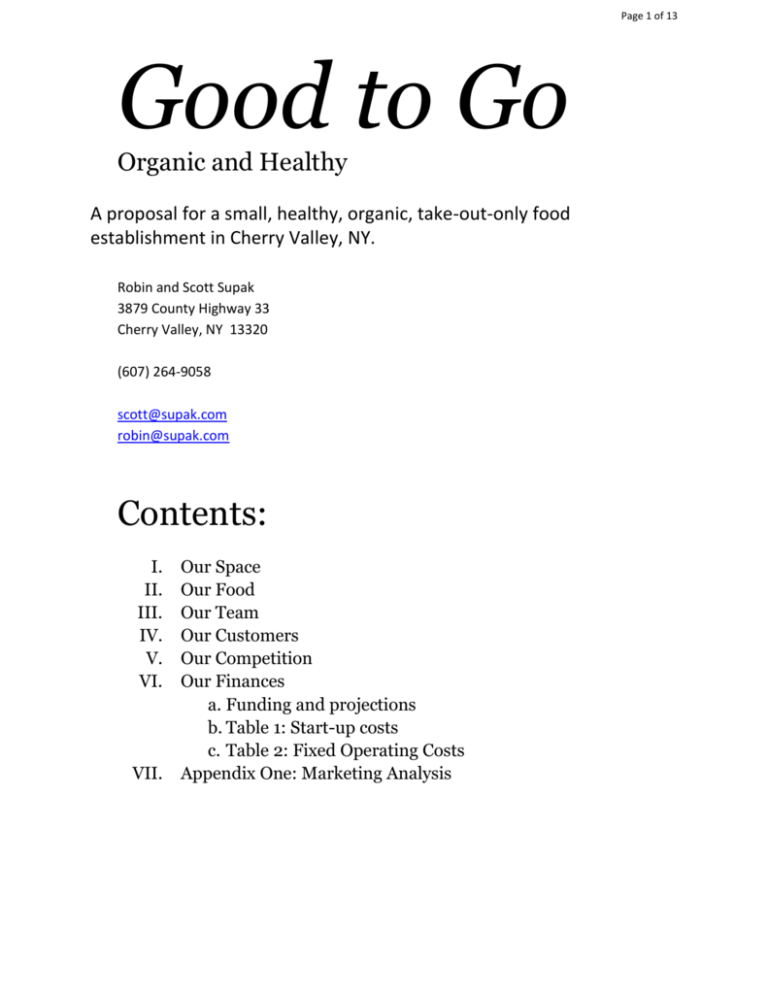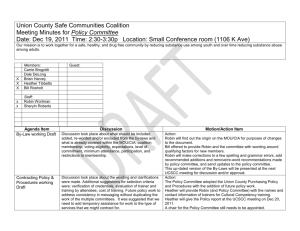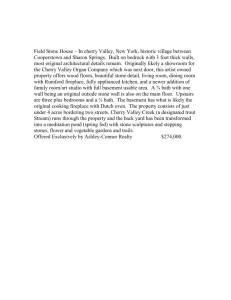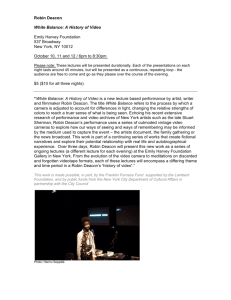Our Food We plan to offer gourmet home cooking using as many
advertisement

Page 1 of 13 Good to Go Organic and Healthy A proposal for a small, healthy, organic, take-out-only food establishment in Cherry Valley, NY. Robin and Scott Supak 3879 County Highway 33 Cherry Valley, NY 13320 (607) 264-9058 scott@supak.com robin@supak.com Contents: I. II. III. IV. V. VI. VII. Our Space Our Food Our Team Our Customers Our Competition Our Finances a. Funding and projections b. Table 1: Start-up costs c. Table 2: Fixed Operating Costs Appendix One: Marketing Analysis Page 2 of 13 Our Space Good to Go will be a small, commercial kitchen selling food to-go via pick-up and, possibly, delivery in Cherry Valley, NY. Our menu will be small, with daily specials being the focus. We will use local, fresh, organic, and healthy ingredients as much as possible. We will offer no seating or wait staff. The front of the store will have a counter where customers pay and pick up food that is either prepackaged and on display, or made to order. Cherry Valley is a small, historic village in central New York State. The Village experiences substantial tourist traffic, especially during the summer months when the Baseball Hall of Fame and the Glimmerglass Opera in nearby Cooperstown are operating near capacity. “Shoulder seasons,” like the spring bloom, the fall leaf season, and even the occasional winter sports season, supply a year-around flow of hungry people. The local residents and commuters through the area include a population of health- and environmentally-conscious consumers. This untapped market for healthy, organic and natural foods offers a substantial base of customers for our small, food service establishment. We have already begun communicating with the county inspector who will be certifying the kitchen for our state 20-C license. He told us our first step is to get plans for an exhaust hood with fire suppression equipment. We hired ABM Fire Equipment in Milford NY and they have drawn up plans for the hood, for which we paid $400. The 20-C license costs $400 every two years, and is included in our monthly fixed operating costs (table 2). We will be hanging a sign with our logo above the door (the rigging is already there from the Nectar Hills Farm sign). We will have a sandwich board that we can put out front on the sidewalk that will feature our specials that day. We will also post the food available each day on our web site, social media, and might advertise our opening and theme days (like taco Tuesday) in various local publications and other affordable advertising outlets, including Google Ads and paid Facebook ads. We will be open for lunch and dinner, generally from 12 am to 6 pm Tuesday through Sunday. Due to the slow nature of the business in the off season, these hours may vary and be flexible, and notices of changes in regular hours will always be posted on our web sites. Special events and summer season might mean extending these hours slightly, but we view our personal relationships with our customers as ways of making arrangements for food pick-up and delivery outside of normal business hours. See Appendix One (page 13) for demographic information on Otsego County. Page 3 of 13 Our Food We plan to offer gourmet home cooking using as many organic and/or local ingredients as possible. Our suppliers will include Nectar Hills Farm who will supply us with organic, grass-fed meats, organic honey, fresh produce, and even, on occasion, cheese and other farm fresh products. We will use Ommegang Brewery beer for marinades, especially for our famous beef jerky. We are currently learning of other local organic farmers and ranchers who will help us meet what we anticipate will be a healthy demand for our healthy food. We will also have other suppliers, including commercial distributors. We are learning about our many choices in this realm from our friends Ellen and David Poulette, who own and operate the health food store Cooperstown Natural Foods, and our friend Cindy Murphy who owned and operated It’s All Good, the former health food store in Cherry Valley. We also plan to get more competition among our suppliers by learning from Richard Frasca and Dana Spiotta about suppliers used for the Rose and Kettle, the Hawkeye Grill, and the Doubleday Café. We plan to pay cash for supplies at first, and when we develop relationships that we like, we may use lines of credit from those suppliers. Our main products will be Robin’s gourmet food. We do not plan to have a fixed menu, but will rather focus on daily specials. We will definitely have a taco Tuesday to focus on one of Robin’s specialties—simple, delicious, healthy Mexican food that is fresh and authentic, as developed by Robin over the years into a to Cali-Mex style. We will offer Robin’s various grass-fed beef jerky flavors in a prepackaged display, as well as Robin’s already locally famous organic biscotti cookies. Daily specials will be made of the best and freshest local and/or organic ingredients available from our suppliers at that time. Our menu will shift from day to day based on availability of ingredients and the season. Our specials will be Italian, Asian, Mexican, Greek, Indian, and American; including spiedies (regional grilled meat specialty sandwich), hamburgers, hot and cold sandwiches, casseroles, hot and cold pasta, stews, soups, and chilies (Robin has improved upon the Supak Family’s award winning Texas Chili). In keeping with our intention to compliment home cooking, we will also sell freshly made sauces and gravies, side dishes, dips, spreads, and even main courses (like lasagna) if ordered in advance (see “back door business”). We also want to offer an array of walking around food, especially in summer, like pomme frite (French fries with various sauces), flavored popcorns, nachos, hot dogs, corn dogs, French toast sticks, egg rolls, and the like. We will also offer fruit smoothies, milk shakes, organic free trade coffee and espresso, as well as other drinks (soda, juices, ice tea, and water). We hope to keep our food affordable. We’re hoping to have an average purchase of about $10 (see Our Finances). This would be a solid meal for one, including a main course and two sides. Robin also plans to offer “The Gang Plank” discounted food that needs to be sold quickly before become outdated. This would help us waste less food and save money; even if we only recoup our food investment from the sale, this is better than sending the food to the garbage or compost pile. Page 4 of 13 Our Team Robin Supak Good to Go has been an evolving dream of Robin Supak’s since she moved to Cherry Valley in 2008. She has worked in the space where Good to Go will be located as an assistant to Sonia Sola, owner of The Nectar Hills Farm Store, which existed in that space until February. Robin has also worked at the Cherry Branch Gallery just a few doors up from the space where Good to Go will be located. Robin has listened carefully to the complaints from locals and tourists alike: "No decent cup of coffee before five?” “No gourmet sandwiches besides going all the way to The Black Cat?” “I missed the Farmer's market, so no in- season veggies (which I don't have time to grow) for us tonight.” “Let's wait and eat on the road.” “Wish we had a picnic to take by the lake." It goes on and on. Cherry Valley needs high-quality, low-commitment food, and Robin is just the person to provide it. Robin has a long history as a creative chef and healthy food specialist. For the last 25 years, as a mother, wife, daughter, relative, or friend of whomever is lucky enough to have a plate of what she’s making; before that as a chef, sous chef, sushi maker, line chef, and bar tender in restaurants and bars from Maui, Hawaii to Los Angeles, California. She has catered events on her own, and helped other catering companies, like the former Woodstock Movable Feast in Woodstock, NY. Robin also worked as a chef at the Rose and Kettle restaurant in Cherry Valley when it was owned by her sister, Dana Spiotta, and former brother-in-law, Clem Coleman. Robin will be the chef for Good to Go. She will keep track of inventory, order supplies and food, and run the day to day operations of the business. Scott Supak Scott is a retired stage technician who co-owns and operates Supak.com, LLC with his wife Robin. Supak.com is a web site marketing company that helps small businesses attract more customers. Scott’s experience running Supak.com, which was founded in 1996 when it published one of the world’s first organic gardening sites, will help market Good to Go using local search promotion techniques, a web site, blog, and social media presence all tied together to promote the latest menu item or specials. Scott will use QuickBooks and Intuit tax preparation software to do the book keeping, accounting, and taxes for the business. He will be in charge of marketing, advertising, and will help with inventory, record keeping, and ordering. He plans to hire outside help when and if he needs it on a contract basis only. Spencer Supak Spencer is the son of Robin and Scott Supak, a high school graduate from Cherry Valley Springfield Central School where he was also a star baseball player. He is well known throughout the area, Page 5 of 13 especially as a rock guitarist, and will be a substantial help in marketing to his friends and their parents through word-of-mouth and social media. Spencer is an excellent driver looking forward to running our delivery service, and he will be helping with food prep, cooking, and janitorial duties. Jasmine Supak Jasmine lives in Los Angeles, CA, where she works as a hair stylist. Her on-line clout in social media, however, makes her a valuable asset for our on-line marketing plan. She will assist in promoting our blog posts on Facebook, Twitter, Instagram, and many other social media and web sites. Richard Frasca Richard is Robin’s step-father, former chef at the Hawkeye Grill in the Otesaga resort in Cooperstown, NY. He has recently taken a new position as the chef at the Double Day Café in Cooperstown. He was a chef and motion pictures caterer in Los Angeles, where he was in charge of catering for movies, such as Titanic. Richard drove, maintained, supplied and managed the catering food truck for Deluxe Catering in Los Angeles. His extensive knowledge of small kitchens and to-go food service offer a valuable resource for the Good to Go venture, where he will help with the set up and design of the kitchen, and could fill in for Robin were she unable to work. Richard also worked at the Rose and Kettle for Clem Coleman and Dana Spiotta when they owned that establishment. Emy Frasca Emy is Robin’s mother and noted organizational and cleanliness expert who volunteers her help and advice on a regular basis. Emy was the manager of the Farmer’s Market Bars for the Gilmore Company in Los Angeles, CA. Richard and Emy owned and operated Cherry Valley Liquors, a wine and liquor store in Cherry Valley, for five years. Emy also worked at the Rose and Kettle when Clem and Dana owned operated it. Emy will help with record keeping, organizing, inventory and other chores similar to the ones she did for the Gilmore Company, the Rose and Kettle, and Cherry Valley Liquors. Page 6 of 13 Our Customers Good to Go’s core customers will be our local co-owners, friends, suppliers, and fellow marketers. In her five years in Cherry Valley, Robin and Scott have made many friends and acquaintances who have fallen in love with her food. Robin’s biscotti and grass-fed beef jerky are legendary to all who have experienced them and are always in high-demand, which this commercial kitchen will finally give her a chance to meet. Judging by the word of mouth that has travelled about the jerky and biscotti, we’re certain that given a little time, word about the delicious food to go, like Robin’s famous chili and tacos, sold at reasonable prices, will travel at least as fast as word of her jerky and biscotti. The Supak family has been on line since 1996. Our web site ranks very high in Google searches for all kinds of various searches. This on-line presence and skill at marketing online will work to our advantage in a more social media driven world. Since most of our friends, suppliers, and various acquaintances also have web and/or social media presence, we plan to use tie-ins with their products and services work for us on the internet as well as in the real world. When we use Nectar Hills Farm grass-fed meats, organic produce, organic honey, and other products, we will not only promote them, but they will promote us. This cross-promotional marketing will substantially help everyone involved, improving demand for all our products. We also plan to crossmarket with Ommegang Brewery in Cooperstown (whose products we use in our jerky and plan to use in various recipes like our famous chili), Beekman 1802 in Sharon Springs (the Beekman Boys have many products which we can use in various ways, and cross-marketing with them would be a bonanza for us, plus they have already met Robin and enjoyed and loved her biscotti and jerky), and many other local businesses whose products or services work in a cross-promotional way. A core of local residents will provide the bulk of our customers over the entire year, but the summer offers especially lucrative possibilities due to the tourism and summer residents associated with the area’s many tourist attractions, including the Baseball Hall of Fame and the Glimmerglass Opera. Approximately 500,000 people visit Otsego County each year, spending $134 million.1 Tourist spending in the Central-Leatherstocking region of New York rose 7.3% between 2010 and 2011 2. Total tourist spending rose 5% in the area from 2011 to 2012.3 Considering the economic recovery has been picking up pace, and that the US dollar has fallen against many world currencies (making international tourism to the US less expensive), we think we can expect even more tourists in our historic area in the near future. President Obama gave a speech at the Baseball Hall of Fame on May 22, 2014, that focused on increasing tourism to our region. 1 http://www.otsegoeconomicdevelopment.com/community_profile/tourism_recreation.html http://www.rocktourism.com/images/pdf/NYS-Tourism-Impact-Hudson-Valley.pdf 3 http://fingerlakestravelny.com/wp-content/uploads/2012/06/NYS-Tourism-Impact-Finger-Lakes.pdf 2 Page 7 of 13 Our Competition Cherry Valley has six restaurants operating at the moment: The Cantina, The Rose and Kettle, The Tryon Inn, The Triangle Tavern, The Coyote Café, and a Subway franchise. All except the Subway are fullservice restaurants with seating. None of these establishments offers organic food on a regular basis; most of them never offer it. Most of them have few, if any, healthy options. All except Subway have wait staff. None have delivery. Mexican food, which is one of Robin’s specialties, is the theme of The Cantina restaurant just a few doors down, but the food is more Cuban or South American, not authentic Mexican. The Cantina, The Rose and Kettle, and The Tryon Inn are all higher-end establishments, offering full service and more expensive meals than we will offer. The Coyote and the Subway offer lower-priced food, but nothing organic or particularly healthy. Considering the quality of our food, we intend to make the price competitive with the non-organic options in the area. Because of our low overhead, we anticipate being able to charge a reasonable amount for our higher quality food, making it competitive, price-wise, with even the lower priced establishments like Subway. The only way to get a healthy, organic diet in this area is to cook it yourself. Many home gardens, local egg producers, and grass-fed meat sellers mean there are many healthy options if people want to shop around and/or raise their own food and cook for themselves. Even for people who do have the time to grow, shop for, and cook their own healthy organic food, our options can help save them work by offering side dishes they would provide the entrée for, or they could purchase our entrées which they can supplement with side dishes of their own. Good to Go food will make it easier for would-be home cooks to forgo a night at a sit-down restaurant for a better, healthier, more organic option-- parts of which they may choose to cook. Only the Coyote Café and the Subway are open for lunch now. We will be the third, and will be the only high-quality food available for lunch. Many of our potential investors and customers have told us we will be getting most of the business they have been giving to those establishments for lunch. Page 8 of 13 Our Finances The small space we’ll be renting will mean Good to Go will have very low overhead. The low rent, lower utility usage, smaller-scale appliances, limited menu choices, lack of wait-staff, and our emphasis on meals ecologically packaged to-go will help us spend considerably less on overhead than our competition. Focusing on providing a good source of healthy, organically produced food, especially from local farmers, rather than depending on summer tourism, will establish Good to Go as a positive addition to a health and environmentally conscious community of artists and others who appreciate the importance of local, organic, and all natural food. As mentioned previously, our number one goal, and the inspiration behind Good to Go, is to provide healthy, organic food at a reasonable price. We plan to do this by keeping our operating costs low. We had thought about starting a small kitchen in the Village for years, but potential spaces were all larger than we needed or would want to afford. More space means more rent, more heat, more electricity, and more problems. When the space for Good to Go became available, it seemed like the answer to our problems. The space is too small to offer seating and wait staff. It is only slightly larger than the inside of a food truck. But without wheels and an engine, our costs would be considerably less. We will take all forms of payment, including checks, all major debit and credit cards, Pay Pal, Dwolla, Google Wallet and any others that are feasible and not overly expensive to use. We do not want to discourage any potential customers by refusing a valid form of payment. We will be following the law regarding whether we might be able to charge a fee to help cover the cost of the cards. We also plan to encourage the use of Dwolla, which is like paypal, except transactions under $10 are free, and over $10 are only $0.25. This would amount to significant savings over normal credit card transactions, which can average between 2% and 3.5% of the bill. Full service restaurants see about 80% of all sales done with plastic, while fast food restaurants see about 35%4. We anticipate somewhere between these numbers, around 50%, mostly for larger orders. We are offering our neighbors, friends and relatives a chance to become initial investors via the sale of shares in the new company Good to Go Organic, LLC (Good to Go). Individual shares in this multipartner LLC, priced at $100 each, represent a 0.1% share of the company. A maximum of 10% of the company will be available to investors via these 100 shares, equaling $10,000 in investor funds. Robin Supak will own 54% of the company. Her payment will be 54% of the profits. Scott Supak will hold 10% of the company and will receive that share of the profits. Spencer Supak will hold 10% of the shares and will receive that share of the profits. Emy Frasca, Richard Frasca, and Jasmine Supak will hold 2% of the shares each, and will be paid that percent. We have no plans to hire any employees (at least in 4 Credit Cards And Restaurants: Industries Mull 'Cashless' Dining Consequences Page 9 of 13 the first few years), and we hope to pay the percentages of the profits due to the co-owners only a biweekly or monthly basis. Any unsold shares from the 20% available to our friends and family will revert to Robin Supak’s ownership. Any of these left-over shares would mean we need to borrow that much more in order to meet out financing needs. This would change the following calculations, leading to a larger amount borrowed, a larger loan payment every month, and a slightly higher break-even point. We anticipate needing $35,813.06 in total startup costs (see table 1 below, Start Up Costs). We anticipate our monthly operating expenses to be $1,291.67 (see table 2 below, Fixed Operating Costs). This does not include the payment of our business loan, which would need to be added to the fixed operating costs. Three months of fixed operating costs equals $3,875, and would be included in the startup capital. $35,813 (startup costs) + $3,875 (three months’ fixed operating costs) = $39,688 $39,688 - $20,000 (investor capital) = $19688 needed, which rounds up to $20,000 A $20,000 loan at 8% interest paid over 5 years would make monthly payment for the loan approximately $405.53 per month. Added to the fixed operating costs (table 2 below), this would make our total monthly fixed operating costs $1697.20 per month. We have our 2008 Saturn Vue to offer as collateral toward the loan. The Kelly Blue book on our vehicle is about $9000. We hope to use NBT bank of Cherry Valley, where our personal and business banking for Supak.com, LLC is now located. We know the people there, and the bank is directly across the street from the Good to Go location, making it the most convenient banking option. Assuming $4 of every $10 meals goes to food and packaging costs (slightly higher than the industry standard of $3 of every $10), we would need to sell eleven $10 orders per day to pass the break even mark (1697.20/ 26 = 65.28 / 6 = 10.87). This calculates to a break-even point of $110 in gross sales every day (with one day off weekly). Based on research provided by our friend and soon-to-be shareholder and customer Kevin Tobler, long time Cherry Valley resident and the executive chef for the Lime Kiln residence for Glimmerglass Opera employees, we expect to attract a daily amount of customers close to the number attracted by Kevin’s former employer, Cantina de Salsa, which is just a few doors down Main Street from Good to Go. While we will not serve alcohol, we expect to make up the numbers of customers who would prefer alcohol by offering a faster, more convenient, higher-quality meal. Kevin estimates The Cantina does 20-45 [people] on a slow day in the winter, 40-75 or more on a weekend per day in the winter. Summer is 45-75 on a slow day, weekends are 175 or more. Taking conservative averages, this would mean an average winter customer total of 35 per day, spending the previously estimated $10 per person average, for a gross income of $350 per day in winter, or triple the break-even point. A conservative average of Kevin’s summer estimates would calculate to about 90 people per day, or $900 gross, over eight times the break-even point. Page 10 of 13 Assuming summer customer numbers for 6 months per year, winter numbers for 6 months (which would make the spring and fall “shoulder seasons” exactly halfway between the summer and winter customer totals) we should expect an average gross income per day, averaged for the whole year, to be $625 per day. (350 + 900 = 1250 / 2 = 625). $625 per day times 6 days a week is $3750, and four weeks at that rate would mean $15,000 per month. Subtracting the 40 cents of every dollar that goes to food and packaging costs, would leave $6000 per month, minus the $1,697.20 in fixed operating costs (table 1), leaves a net profit of $4302.80 every month (to be split among the shareholders). Finally, our kitchen will also be able to supply catered events, sometimes referred to as “back door” business. We plan to advertise the fact that we can prepare meals to order for large groups, perfect for catering any event. While demand for catering may bring in less revenue than our foot traffic will provide, this high volume business could become a very lucrative source of additional revenue once word gets out. Page 11 of 13 Table 1: Start-up costs Equipment Exhaust Hood Plans Used exhaust hood, installed Hot water heater, installed Sinks, installed Propane tank and gas lines, installed Oven, installed Stove top and grill, installed Checkout Counter Electric service improvements Cash register / credit card machine Grease trap Miscellaneous Equipment, tools, utensils Cuisinart Griddler Deluxe Chef'sChoice PetitePie Baker with Timer Breville Milk Cafe Automatic Milk Frother, BMF600XL Breville Smart Deep Fryer, BDF500XL Restaurant-Quality French Fry Cutter T-Fal ActiFry deep fryer Stainless-Steel Mixing Bowls with Lids 2-qt. stainless-steel bowl Breville Original Toastie Sandwich Maker Cuisinart 14 cup Food Processor, FP-14 Cuisinart 7- and 11-Cup Food Processor Disc Sets Breville Infuser Espresso Machine, BES840XL Puckoven Pressure oven Le Creuset Tri-Ply Stainless Steel Covered Saucepan 4 qt Certified Reconditioned Next Generation Programs Floor Mats (16) MIU France Stainless Steel Magnetic Knife Bar (2) Advance Tabco Bakers Prep Table 72 BG306 Turbo Air Refrigerated Merchandiser TGM35R TRUE Freezer Reachin 1section 23 cu. ft. T23F TRUE Refrigerator Reachin 1section 23 cu. ft. T23 Work Table - 24" x 72" (2) Wire Shelving - 24" x 48" (2) Eagle Group MT2448B Wood Top Work Table - 24" x 48" (2) Various kitchen utensils Lighting Trash, recycling, composting Signs Total $35,813.06 Cost $400.00 $8,000.00 $2,500.00 $1,000.00 $1,000.00 $2,000.00 $2,000.00 $1,000.00 $1,000.00 $500.00 $500.00 $1,000.00 $159.00 $79.95 $129.95 $129.95 $79.95 $199.95 $69.95 $19.95 $79.95 $199.95 $79.95 $499.95 $249.95 $164.95 $519.00 $265.44 $59.98 $1,095.07 $2,319.37 $2,793.02 $2,234.95 $339.90 $337.00 $605.98 $1,000.00 $1,000.00 $200.00 $300.00 Page 12 of 13 Table 2: Fixed Operating Costs Bill Rent Electricity Gas Cable, phone, internet Insurance 20-C license Water Waste advertising Loan payment Staples Cost/mo $150.00 $200.00 $135.00 Total $150.00 $100.00 $16.67 $20.00 $20.00 $200.00 $405.53 $300.00 $1697.20 Notes on operating expenses Electricity and gas usage is based on square footage and using the California Commercial End-Use Survey5 (which we think over estimates energy use for our small kitchen because we won't have any seating, dishwashing, or other costs associated with restaurants as opposed to to-go kitchens), we find that an average restaurant uses around 40.2 kw/h annually per square foot. Our kitchen space is approximately 176 square feet, which would be 7075 kw hours per year, or 589 kw/hours per month. Based on the rough estimates provided by Heather K. from National Grid in a phone call on 3/25/2014, our estimate of 589 kw hours per month would have a supply cost of $0.18/kw, a delivery cost of $0.15/kw, which, added to the base delivery charge of $21.02/mo, would make our total electric bill every month around $194.56/mo (which we will round up to $200). Using the same table from the California Commercial End-Use Survey to estimate our gas utility costs (propane), we see that the average restaurant uses 209,000 BTU's per square foot per year. This would be 36,784,000 BTU's per year, which converts6 to 403 gallons of propane per year, which at a price of about $4 a gallon7 comes to $1612 per year, or about $135 per month. 5 Table 8-1, page 150, http://www.energy.ca.gov/2006publications/CEC-400-2006-005/CEC-400-2006-005.PDF http://www.frontiernaturalgas.com/NewHome/btu-conversion-guide.php 7 https://www.nyserda.ny.gov/Energy-Data-and-Prices-Planning-and-Policy/Energy-Prices-Data-andReports/Energy-Prices/Propane/Average-Propane-Prices.aspx 6 Page 13 of 13 Appendix One Market Analysis: The total population for Otsego County is estimated in 2013 to be 61,540 with total households estimated to be 24,301. Otsego County has over 24,301 households and median age is 41.2 years old. The population is made up of the highest percentage of people age 45 to 54 (14.3%), the next is people age 55 to 64 (14.0%) and then people age 20 to 24 represent 10.9% of the total population. Surveyed results reflect households by income indicate the largest percentage of residence earn between $50,000 and $74,999. This percentage is 23.1% or 5,637 people of the total 61,540. The second largest percentage of household income level is the $35,000 to $49,999 range at 15.7% or 3,828 people. The average household income in Otsego County is $60,042 and the median household income is $47,223. Otsego County has over 30,926 housing units with 71.8% being owner occupied or 17,467. Other housing units are renter occupied at 6,834 or 28.1% and vacant houses total 6,625 or 21.4% of the total housing units. In Otsego County 56.2% of all households have 2 or more vehicles in the county followed by 1 vehicle at 34.4% or 8,367 households. The Otsego County population of 61,540 has 44.7% of the total population currently married or 23,608. The next highest percentage is in the never married at 35.6% or 18,818 people. The population of the County has had a majority of its people obtaining a high school education at 32.2% or 12,921. The next highest level of education obtained is a bachelor’s degree for 16.2% of the population or 6,498 people. The population of Otsego County has 3,820 children in grade schools from kindergarten to 12th grade. Otsego County has 2,534 established businesses. The established businesses have over 23,925 employees. The major industry in Otsego County is service at 49.6% of the total business establishments and 11,887 employees. The second largest industry is retail trade at 18.5% of the total business with over 4,444 employees. The service industry is broken down into several sectors: the largest is Health Services at 16.7%, then Educational Services at 14.4%. The retail sector is broken down into different sectors as well: both Food Stores and Eating and Drinking Places are at 4.2%, having 1,007 employees and 1,023 employees, respectively.




